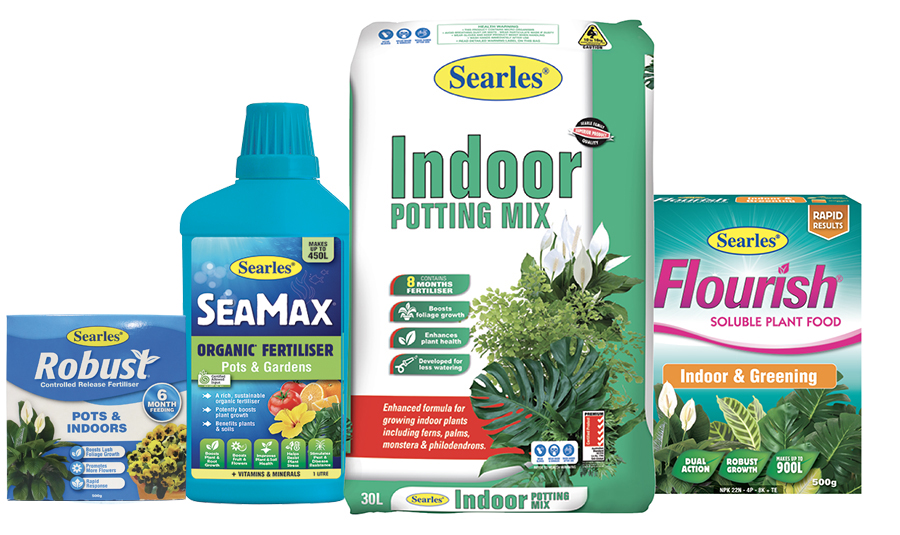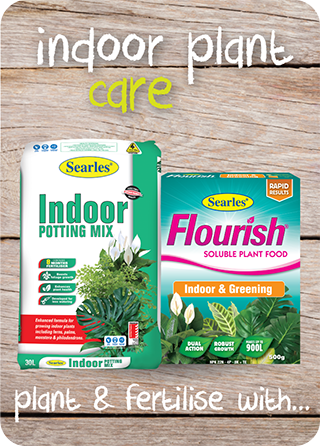HOW TO CARE FOR INDOOR PLANTS
 |
|
With a little love and know-how, your indoor plants will look happy and healthy with lush growth for a green indoor sanctuary we all desire. As soon as you bring your newly purchased pot plant home, re-pot the plant into a premium quality potting mix such as Searles Indoor Potting Mix. This mix is manufactured to a consistently high quality providing plants the optimal drainage, aeration, water holding capacity, pH, fertiliser and nutrients for healthy plant growth. Do not use soil from garden beds or straight from the ground. This soil may contain weeds, fungal problems, unwanted bugs, and usually causes many issues if used in pots. After removing the plant from its container for re-potting, check for signs of root rot or pests and diseases and treat promptly. For best results select a large enough container with drainage holes to allow for future growth and excellent drainage. For good drainage and adequate aeration, choose a container that is taller than it is wide, and ensure that if re-potting, move to the next size pot only. Position the plant into the new pot so the surface of the rootball is at the same level as it was in the old pot. After re-potting, water the plant well, washing off any stray potting mix from the foliage. It is a good idea to give newly potted plants a liquid feed with SeaMax Organic Fertiliser to promote root settlement and encourage healthy new growth.
POSITION For the ideal position of your particular plant indoors, check the plant’s care label for their ideal light requirements. Natural light is essential to indoor plants. Though some do quite well in dim surroundings, most need at least indirect sunlight for several hours a day to flourish and produce better flowering. Don’t position indoor plants in direct sunlight, or too close to window glass, as the leaves can still burn, even in winter. Indoor plants love bathrooms, kitchens and living rooms where bright indirect light is generally in abundant supply. Throughout the year the plant’s position may need to change slightly. The summer sun may be too strong for the plants current position and may need to be shifted into a more protected spot, away from hot window glass, until the strongest part of summer is over. During winter, move indoor plants to the brighter, warmer areas of the house. Winter days receive fewer daylight hours due to the lower angle of the sun in the sky. Keep plants away from heaters and cold draughts from air-conditioners. If you are running the heater or cooler for the majority of the day, plants might need a light misting to help re-hydrate them or simply move them to another area of the house with less exposure. To prevent uneven growth, quarter-turn pots regularly so all sides of the plants are exposed equally to the light.
WATERING Watering varies greatly from plant to plant. Some love to be watered every second or third day, some like their soil to dry out between watering. Check the plant label for watering directions. It is important to get the balance right. Too much water and the soil will be waterlogged and lead to root rot. Not enough watering and the leaves tips will start to brown and growth will be poor. Always tip out excess water from cover pots and saucers to avoid waterlogging. Be mindful to adjust your watering regime throughout the different seasons. Increase watering during hot summer days and reduce during the winter months. Look out for water repellent soil. Old potting mix and infrequent watering may lead to hydrophobic soil. When the soil is watered and the water pools on top of the soil and doesn’t soak into the soil or the water runs of to the side, the soil is considered hydrophobic. Sprinkle Searles Penetraide onto the soil to promote better water absorption. This is ideal for pots and garden beds, as its benefits last for up to 12 months.
FERTILISE Indoor plants respond well to regular fertilising. Which type of fertiliser to use is up to you. You may choose to liquid fertilise while watering fortnightly with an instant fertiliser. Instant fertilisers like Searles Flourish Soluble Indoor & Greening will quickly provide the soil with the nutrients it needs for fast results. Controlled Release Fertilisers such as Searles Robust Pots & Gardens, are popular to sprinkle onto indoor plants, once each few months, as they release fertiliser to the plants slowly and sustainability. Ideal times to fertilise indoor plants are at the end of winter and the start of spring for an early burst of spring growth, during summer and again in autumn for continued growth during the main growing seasons.
PEST WATCH & PLANT AILMENTS FOR INDOOR PLANTS Maintain your vigilance for pests such as aphids and mealybug. Look for them on new growth and plant stems. Control with Searles Bug Beater or Searles Pest Gun. To discourage fungus gnats, keep the soil slightly dry and create a natural barrier, such as mulching over the soil, to stop the gnats from laying their eggs in the soil. Poor plant health due to nutrient imbalance, incorrect lighting or variable watering regimes can weaken the plant's defence against pests & diseases. Check out our Complete Indoor Plant Guide for further information on pests and diseases and general indoor plant care. For Indoor Potting Mix stockists click here
|
|






